Accessibility in Native Mobile Applications for Users with Disabilities: A Scoping Review
Abstract
1. Introduction
2. Background and Motivation
Mobile Applications and Accessibility
3. Method Applied for Scoping Review
3.1. Definition of the Research Questions to Determine the Scope
3.2. Search Strategy to Extract the Documents
3.3. Screening of Documents
3.4. Data Extraction and Review Process
4. Results
4.1. Bibliometric Analysis
4.2. Review of the Literature to Map the Studies
4.2.1. RQ1. What Are the Disabilities That Are Most Considered for Accessibility Evaluation in Mobile Applications?
- (1)
- Cognitive or intellectual disability is an issue considered by mental development that disturbs the learning method.
- (2)
- Motor coordination is a problem associated with a deficiency of one or more parts of the body’s change capabilities.
- (3)
- Sensory disability is related to (1) vision, including low vision and deafness; (2) hearing impairment, which provides deafness and hearing loss.
4.2.2. RQ2. What Methods and Techniques Are Applied to Evaluate Accessibility in Mobile Applications?
- (1)
- Automatic: consists of using an automatic review tool for which it is required to install an app on the mobile device, which issues a report of the accessibility barriers encountered.
- (2)
- Combined: consists of using two methods—one automatic and one manual. In the first phase, an automatic review tool is used. A manual review method is applied in the second phase, a simple manual process, or a more sophisticated method such as a heuristic.
- (3)
- Heuristic: a manual method based on establishing a scale of values assigned to a set of accessibility barriers (heuristics) reviewed manually by an accessibility expert.
- (4)
- Manual: based on a manual review process performed by an accessibility expert, not necessarily involving scales and heuristics.
4.2.3. RQ3. What Are the Accessibility Guidelines Applied to Mobile Applications to Achieve Accessibility?
- (1)
- WCAG 2.0 incorporates the primary research utilizing the Web Content Accessibility Guidelines with version 2.0 [39] to improve mobile application accessibility.
- (2)
- WCAG 2.1 comprises the primary researches that employed the Web Content Accessibility Guidelines with version 2.1 [4] to improve mobile application accessibility.
- (3)
- MWAG (Mobile Web Accessibility Guidelines) refers to the guidelines used to evaluate accessibility in mobile applications specified by the W3C.
- (4)
- Other guidelines include the primary research that helps improve accessibility in mobile applications by employing guidelines without specifying the standard.
4.2.4. RQ4. What Type of Research and Contributions Has Been Found Related to Mobile Applications and Accessibility?
- (1)
- Mixed research comprises a process that collects, analyzes, and pours quantitative and qualitative data into the same research study.
- (2)
- Qualitative research is an inductive and adaptive model conducted through narrative inspection of applications. This research includes small-scale research, emphasizes the validity of the research through immediacy to empirical actuality, and often does not test notions or hypotheses; statistical analysis is not possible.
- (3)
- Quantitative research generates numerical data that allow data to be accumulated and examined. This research relies on objectivity to arrive at learning; it uses specific, self-controlled dimensions. This research contains combined methods and assessments for data collection.
4.2.5. RQ5. What Tools Are Used to Test Accessibility in Mobile Applications?
- (1)
- Accessibility Scanner: this is an automatic review tool from Google Play; it evaluates accessibility in Android applications without advanced technical knowledge.
- (2)
- Not specified: it does not specify the use of any tool to assess the accessibility of mobile applications; they are based on manual methods with guidelines defined according to some standards or defined by the authors performing the evaluation.
4.2.6. RQ6. Which Domains Are the Most Evaluated?
5. Discussion
6. Conclusions
Author Contributions
Funding
Institutional Review Board Statement
Informed Consent Statement
Data Availability Statement
Conflicts of Interest
Appendix A
| SECTION | ITEM | PRISMA-ScR CHECKLIST ITEM | REPORTED ON PAGE # |
|---|---|---|---|
| TITLE | |||
| Title | 1 | Identify the report as a scoping review. | 1 |
| ABSTRACT | |||
| Structured summary | 2 | Provide a structured summary that includes (as applicable): background, objectives, eligibility criteria, sources of evidence, charting methods, results, and conclusions that relate to the review questions and objectives. | 1, 2 |
| INTRODUCTION | |||
| Rationale | 3 | Describe the rationale for the review in the context of what is already known. Explain why the review questions/objectives lend themselves to a scoping review approach. | 2 |
| Objectives | 4 | Provide an explicit statement of the questions and objectives being addressed with reference to their key elements (e.g., population or participants, concepts, and context) or other relevant key elements used to conceptualize the review questions or objectives. | 3 |
| METHODS | |||
| Protocol and registration | 5 | Indicate whether a review protocol exists; state if and where it can be accessed (e.g., a web address); and if available, provide registration information, including the registration number. | 3–7 |
| Eligibility criteria | 6 | Specify characteristics of the sources of evidence used as eligibility criteria (e.g., years considered, language, and publication status) and provide a rationale. | 2, 4, 7 |
| Information sources* | 7 | Describe all information sources in the search (e.g., databases with dates of coverage and contact with authors to identify additional sources), as well as the date the most recent search was executed. | 5, 6, 7 |
| Search | 8 | Present the full electronic search strategy for at least one database, including any limits used, such that it could be repeated. | 4 |
| Selection of sources of evidence† | 9 | State the process for selecting sources of evidence (i.e., screening and eligibility) included in the scoping review. | 4, 5, 6 |
| Data charting process‡ | 10 | Describe the methods of charting data from the included sources of evidence (e.g., calibrated forms or forms that have been tested by the team before their use, and whether data charting was carried out independently or in duplicate) and any processes for obtaining and confirming data from investigators. | 6 |
| Data items | 11 | List and define all variables for which data were sought and any assumptions and simplifications made. | 5–6 |
| Critical appraisal of individual sources of evidences | 12 | If completed, provide a rationale for conducting a critical appraisal of included sources of evidence; describe the methods used and how this information was used in any data synthesis (if appropriate). | 9 |
| Synthesis of results | 13 | Describe the methods of handling and summarizing the data that were charted. | 8–9 |
| RESULTS | |||
| Selection of sources of evidence | 14 | Give numbers of sources of evidence screened, assessed for eligibility, and included in the review, with reasons for exclusions at each stage, ideally using a flow diagram. | 7, 13 |
| Characteristics of sources of evidence | 15 | For each source of evidence, present characteristics for which data were charted and provide the citations. | 8, 13 |
| Critical appraisal within sources of evidence | 16 | If completed, present data on critical appraisal of included sources of evidence (see item 12). | 9 |
| Results of individual sources of evidence | 17 | For each included source of evidence, present the relevant data that were charted that relate to the review questions and objectives. | 9 |
| Synthesis of results | 18 | Summarize and/or present the charting results as they relate to the review questions and objectives. | 8–13 |
| DISCUSSION | |||
| Summary of evidence | 19 | Summarize the main results (including an overview of concepts, themes, and types of evidence available), link to the review questions and objectives, and consider the relevance to key groups. | 14–15 |
| Limitations | 20 | Discuss the limitations of the scoping review process. | 14 |
| Conclusions | 21 | Provide a general interpretation of the results with respect to the review questions and objectives, as well as potential implications and/or next steps. | 14–15 |
| FUNDING | |||
| Funding | 22 | Describe sources of funding for the included sources of evidence, as well as sources of funding for the scoping review. Describe the role of the funders of the scoping review. | 15 |
References
- Statista. Number of Available Apps in the Apple App Store from 2008 to 2020. 2020. Available online: https://www.statista.com/statistics/268251/number-of-apps-in-the-itunes-app-store-since-2008/ (accessed on 21 February 2021).
- Acosta-Vargas, P.; Serrano-Costales, L.; Salvador-Ullauri, L.; Nunes, I.I.; Gonzalez, M. Toward Accessible Mobile Application Development for Users with Low Vision. Adv. Intell. Syst. Comput. 2020, 1207 AISC, 236–241. [Google Scholar] [CrossRef]
- World Wide Web Consortium Mobile Accessibility: How WCAG 2.0 and Other W3C/WAI Guidelines Apply to Mobile. Available online: https://www.w3.org/TR/mobile-accessibility-mapping/ (accessed on 16 September 2018).
- World Wide Web Consortium. Web Content Accessibility Guidelines (WCAG) 2.1. 2018. Available online: https://www.w3.org/TR/WCAG21/ (accessed on 27 March 2021).
- Google Google Trends. Available online: https://trends.google.com/trends/explore (accessed on 13 May 2021).
- Qbilat, M.; Iglesias, A.; Belpaeme, T. A Proposal of Accessibility Guidelines for Human-Robot Interaction. Electronics 2021, 10, 561. [Google Scholar] [CrossRef]
- Alsaeedi, A. Comparing Web Accessibility Evaluation Tools and Evaluating the Accessibility of Webpages: Proposed Frameworks. Information 2020, 11, 40. [Google Scholar] [CrossRef]
- Acosta, T.; Acosta-Vargas, P.; Lujan-Mora, S. Accessibility of eGovernment Services in Latin America; Teran, L., Meier, A., Eds.; Institute of Electrical and Electronics Engineers Inc.: New York, NY, USA, 2018; pp. 67–74. [Google Scholar]
- Eriksen, M.B.; Frandsen, T.F. The impact of patient, intervention, comparison, outcome (PICO) as a search strategy tool on literature search quality: A systematic review. J. Med. Libr. Assoc. 2018, 106, 420. [Google Scholar] [CrossRef] [PubMed]
- PRISMA Statement. PRISMA for Scoping Reviews. 2021. Available online: http://www.prisma-statement.org/Extensions/ScopingReviews (accessed on 27 May 2021).
- Jabangwe, R.; Edison, H.; Duc, A.N. Software engineering process models for mobile app development: A systematic literature review. J. Syst. Softw. 2018, 145, 98–111. [Google Scholar] [CrossRef]
- Acosta-Vargas, P.; Salvador-Ullauri, L.; Pérez-Medina, J.L.; Zalakeviciute, R.; Hernandez, W. Heuristic method of evaluating accessibility of mobile in selected applications for air quality monitoring. Adv. Intell. Syst. Comput. 2020, 959, 485–495. [Google Scholar] [CrossRef]
- Acosta-Vargas, P.; Salvador-Acosta, B.; Zalakeviciute, R.; Alexandrino, K.; Pérez-Medina, J.-L.; Rybarczyk, Y.; Gonzalez, M. Accessibility Assessment of Mobile Meteorological Applications for Users with Low Vision; Springer: Cham, Switzerland, 2020. [Google Scholar]
- Silva, G.M.S.; Andrade, R.M.D.C.; Ticianne de Gois, R.D. Design and Evaluation of Mobile Applications for People with Visual Impairments: A Compilation of Usable Accessibility Guidelines. In Proceedings of the Symposium on Human Factors in Computing Systems, Victoria, Brazil, 21–25 October 2019; pp. 1–10. [Google Scholar]
- Park, E.; Han, S.; Bae, H.; Kim, R.; Lee, S.; Lim, D.; Lim, H. Development of Automatic Evaluation Tool for Mobile Accessibility for Android Application. In Proceedings of the International Conference on Systems of Collaboration Big Data, Internet of Things & Security, Casablanca, Morocco, 12–13 December 2019; IEEE: New York, NY, USA, 2019; pp. 1–6. [Google Scholar]
- Carneiro, M.; Branco, F.; Gonçalves, R.; Au-Yong-Oliveira, M.; Moreira, F.; Martins, J. Accessibility in Mobile Applications of Portuguese Public Administration. In Proceedings of the International Conference on Human-Computer Interaction, Orlando, FL, USA, 26–31 July 2019; Springer: Cham, Switzerland, 2019; pp. 243–256. [Google Scholar]
- Ballantyne, M.; Jha, A.; Jacobsen, A.; Hawker, J.S.; El-Glaly, Y.N. Study of Accessibility Guidelines of Mobile Applications. In Proceedings of the International Conference on Mobile and Ubiquitous Multimedia, Cairo, Egypt, 25–28 November 2018; pp. 305–315. [Google Scholar]
- Acosta-Vargas, P.; Zalakeviciute, R.; Luján-Mora, S.; Hernandez, W. Accessibility Evaluation of Mobile Applications for Monitoring Air Quality; Springer: Cham, Switzerland, 2019; pp. 1–11. [Google Scholar]
- Kitchenham, B.; Pearl Brereton, O.; Budgen, D.; Turner, M.; Bailey, J.; Linkman, S. Systematic literature reviews in software engineering—A systematic literature review. Inf. Softw. Technol. 2009, 51, 7–15. [Google Scholar] [CrossRef]
- Barbara, C.S. Guidelines for Performing Systematic Literature Reviews in Software Engineering; University of Durham: Durham, UK, 2007; pp. 1–44. [Google Scholar] [CrossRef]
- Saha, S.K.; Barton, C.; Promite, S.; Mazza, D. Knowledge, Perceptions and Practices of Community Pharmacists Towards Antimicrobial Stewardship: A Systematic Scoping Review. Antibiotics 2019, 8, 263. [Google Scholar] [CrossRef] [PubMed]
- Idostatistics. Cohen’s Kappa Free Calculator. 2020. Available online: https://idostatistics.com/cohen-kappa-free-calculator/#risultati (accessed on 17 May 2021).
- PRISMA Statement. PRISMA Flow Diagram. 2021. Available online: http://prisma-statement.org/prismastatement/flowdiagram.aspx (accessed on 27 May 2021).
- Jain, Y.K.; Bha, S.K. Min max normalization based data perturbation method for privacy protection. Int. J. Comput. Commun. Technol. 2011, 2, 45–50. [Google Scholar]
- Acosta-Vargas, P.; Salvador-Ullauri, L.; Jadán-Guerrero, J.; Guevara, C.; Sanchez-Gordon, S.; Calle-Jimenez, T.; Lara-Alvarez, P.; Medina, A.; Nunes, I.L. Accessibility Assessment in Mobile Applications for Android. In Proceedings of the International Conference on Applied Human Factors and Ergonomics, Washington, DC, USA, 24–28 July 2019; Springer: Cham, Switzerland, 2020; Volume 959, pp. 279–288. [Google Scholar]
- Carvalho, M.C.; Dias, F.S.; Reis, A.G.; Freire, A.P. Accessibility and usability problems encountered on websites and applications in mobile devices by blind and normal-vision users. In Proceedings of the 33rd Annual ACM Symposium on Applied Computing, New York, NY, USA, 9–13 April 2018; ACM: New York, NY, USA, 2018; pp. 2022–2029. [Google Scholar]
- Zhang, X.; Ross, A.S.; Fogarty, J. Robust Annotation of Mobile Application Interfaces in Methods for Accessibility Repair and Enhancement. In Proceedings of the 31st Annual ACM Symposium on User Interface Software and Technology, Berlin, Germany, 14–17 October 2018; pp. 609–621. [Google Scholar]
- Kim, W.J.; Kim, I.K.; Kim, J.; Kim, M. UX Design Guideline for Health Mobile Application to Improve Accessibility for the Visually Impaired: Focusing on Disease Retinitis Pigmentosa. Mob. Appl. Solut. Soc. Incl. 2018, 288–309. [Google Scholar] [CrossRef]
- Russ, K.C.W. An Assistive Mobile Application i-AIM App with Accessible UI Implementation for Visually-Impaired and Aging Users. In Proceedings of the 6th International Conference on Information and Communication Technology and Accessibility, ICTA, Muscat, Oman, 19–21 December 2017; pp. 1–6. [Google Scholar] [CrossRef]
- Ross, A.S.; Zhang, X.; Fogarty, J.; Wobbrock, J.O. Epidemiology as a Framework for Large-Scale Mobile Application Accessibility Assessment. In Proceedings of the 19th International ACM SIGACCESS Conference on Computers and Accessibility, Baltimore, MD, USA, 20 October–1 November 2017; pp. 2–11. [Google Scholar] [CrossRef]
- Zhang, X.; Ross, A.S.; Caspi, A.; Fogarty, J.; Wobbrock, J.O. Interaction Proxies for Runtime Repair and Enhancement of Mobile Application Accessibility. In Proceedings of the 2017 CHI Conference on Human Factors in Computing Systems, ACM, Denver, CO, USA, 6–11 May 2017; pp. 6024–6037. [Google Scholar]
- Choi, H.; Park, J.W. Methods to Improve Mobile Application Accessibility through Applying a Tactile User Interface in a Smartphone. Int. Inf. Inst. 2016, 19, 5327–5335. [Google Scholar]
- Nathan, S.S.; Hussain, A.; Hashim, N.L. Deaf Mobile Application Accessibility Requirements. In AIP Conference Proceedings; AIP Publishing LLC: Melville, NY, USA, 2016; Volume 1761, p. 020098. [Google Scholar]
- Balaji, V.; Kuppusamy, K.S. Accessibility Analysis of E-Governance Oriented Mobile Applications. In Proceedings of the 2016 International Conference on Accessibility to Digital World (ICADW), Guwahati, India, 16–18 December 2016. [Google Scholar] [CrossRef]
- Kim, W.J.; Kim, I.K.; Jeon, M.K.; Kim, J. UX Design Guideline for Health Mobile Application to Improve Accessibility for the Visually Impaired. In Proceedings of the International Conference on Platform Technology and Service, Jeju, Korea, 15–17 February 2016; IEEE: Piscataway, NJ, USA, 2016; pp. 1–5. [Google Scholar]
- Carvalho, L.P.; Ferreira, L.P.; Freire, A.P. Accessibility Evaluation of Rich internet Applications Interface Components for Mobile Screen Readers. In Proceedings of the 31st Annual ACM Symposium on Applied Computing, Pisa, Italy, 4–8 April 2016; ACM: New York, NY, USA, 2016; pp. 181–186. [Google Scholar]
- Billi, M.; Burzagli, L.; Catarci, T.; Santucci, G.; Bertini, E.; Gabbanini, F.; Palchetti, E. A unified methodology for the evaluation of accessibility and usability of mobile applications. Univers. Access Inf. Soc. 2010, 9, 337–356. [Google Scholar] [CrossRef]
- Acosta-Vargas, P.; Salvador-Acosta, B.; Salvador-Ullauri, L. (Dataset) Accessibility in Mobile Applications: Scoping Review. In Mendeley Data Version 6; 2021. [Google Scholar] [CrossRef]
- World Wide Web Consortium. Web Content Accessibility Guidelines (WCAG) 2.0. 2008. Available online: https://www.w3.org/TR/WCAG20/ (accessed on 14 March 2021).
- Lu, D.J.; Girgis, M.; David, J.M.; Chung, E.M.; Atkins, K.M.; Kamrava, M. Evaluation of Mobile Health Applications to Track Patient-Reported Outcomes for Oncology Patients: A Systematic Review. Adv. Radiat. Oncol. 2021, 6, 100576. [Google Scholar] [CrossRef]
- Salvador-Ullauri, L.; Acosta-Vargas, P.; Gonzalez, M.; Luján-Mora, S. Combined Method for Evaluating Accessibility in Serious Games. Appl. Sci. 2020, 10, 6324. [Google Scholar] [CrossRef]
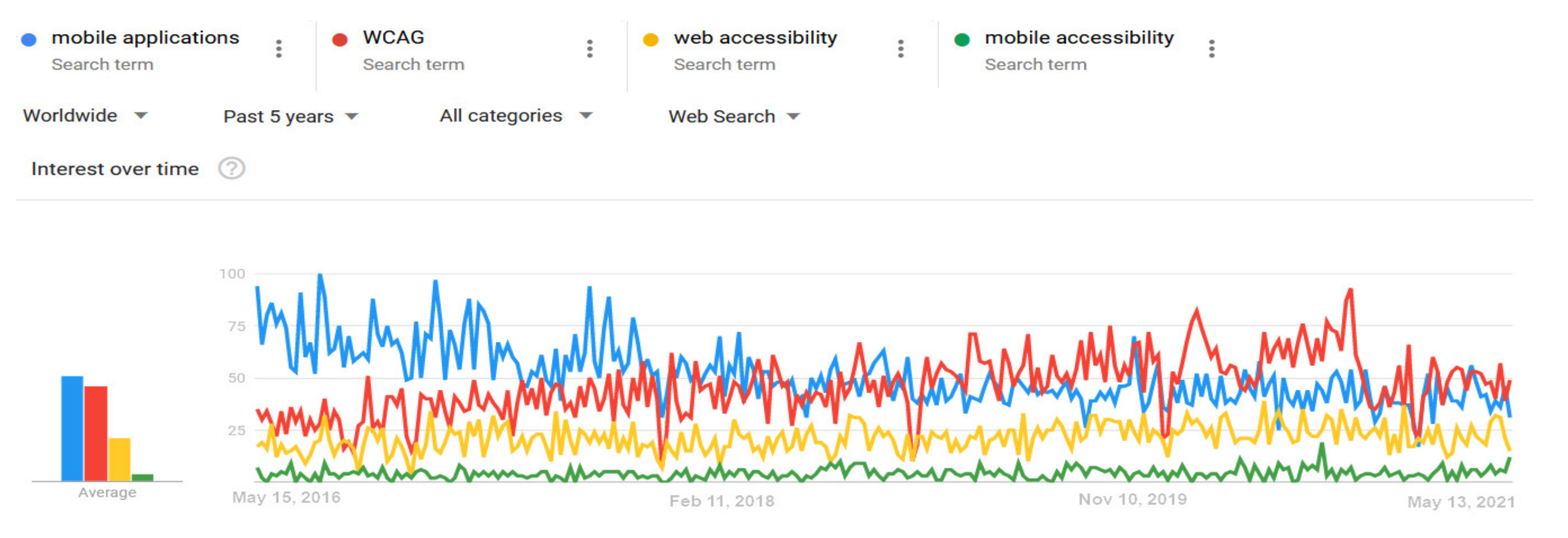
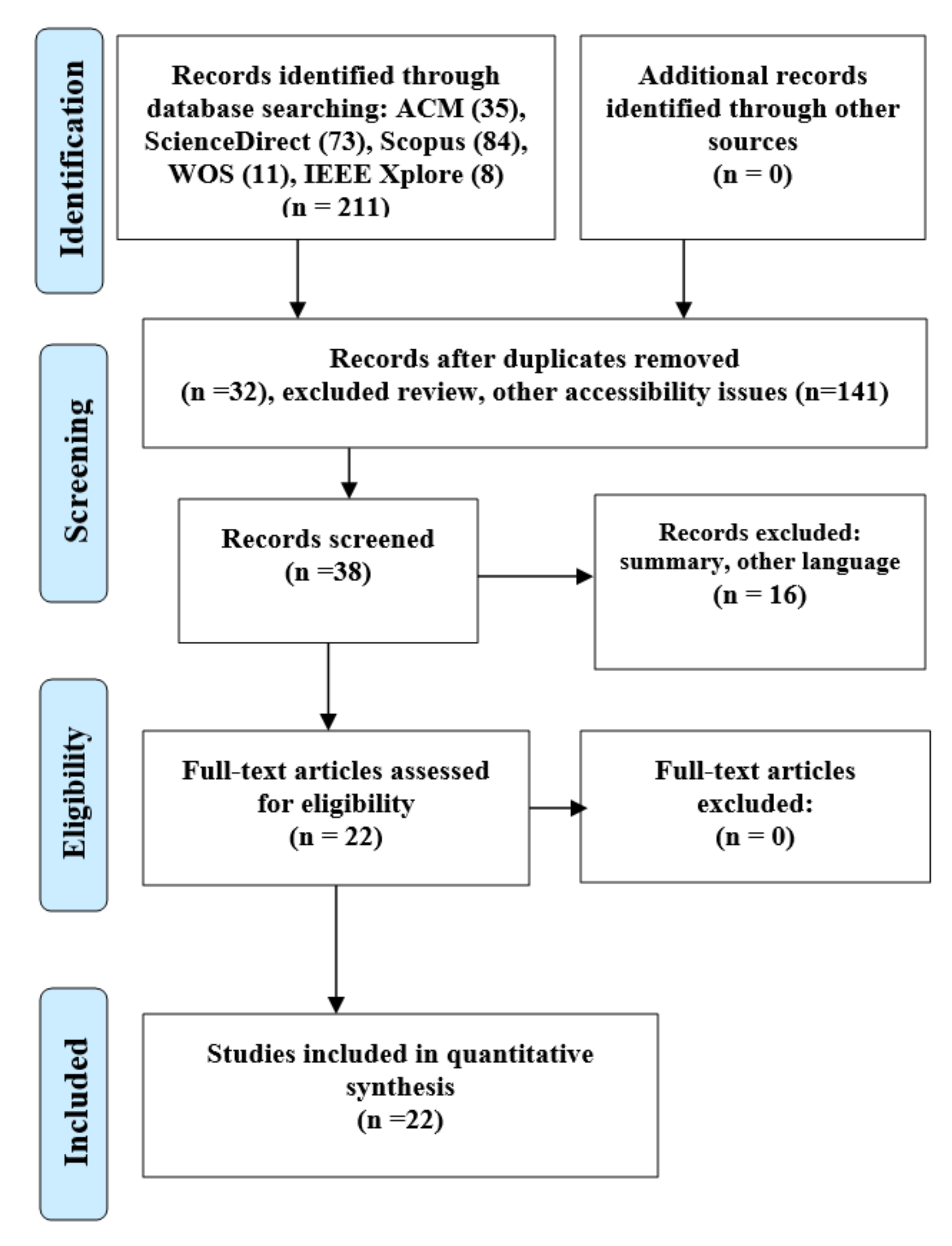

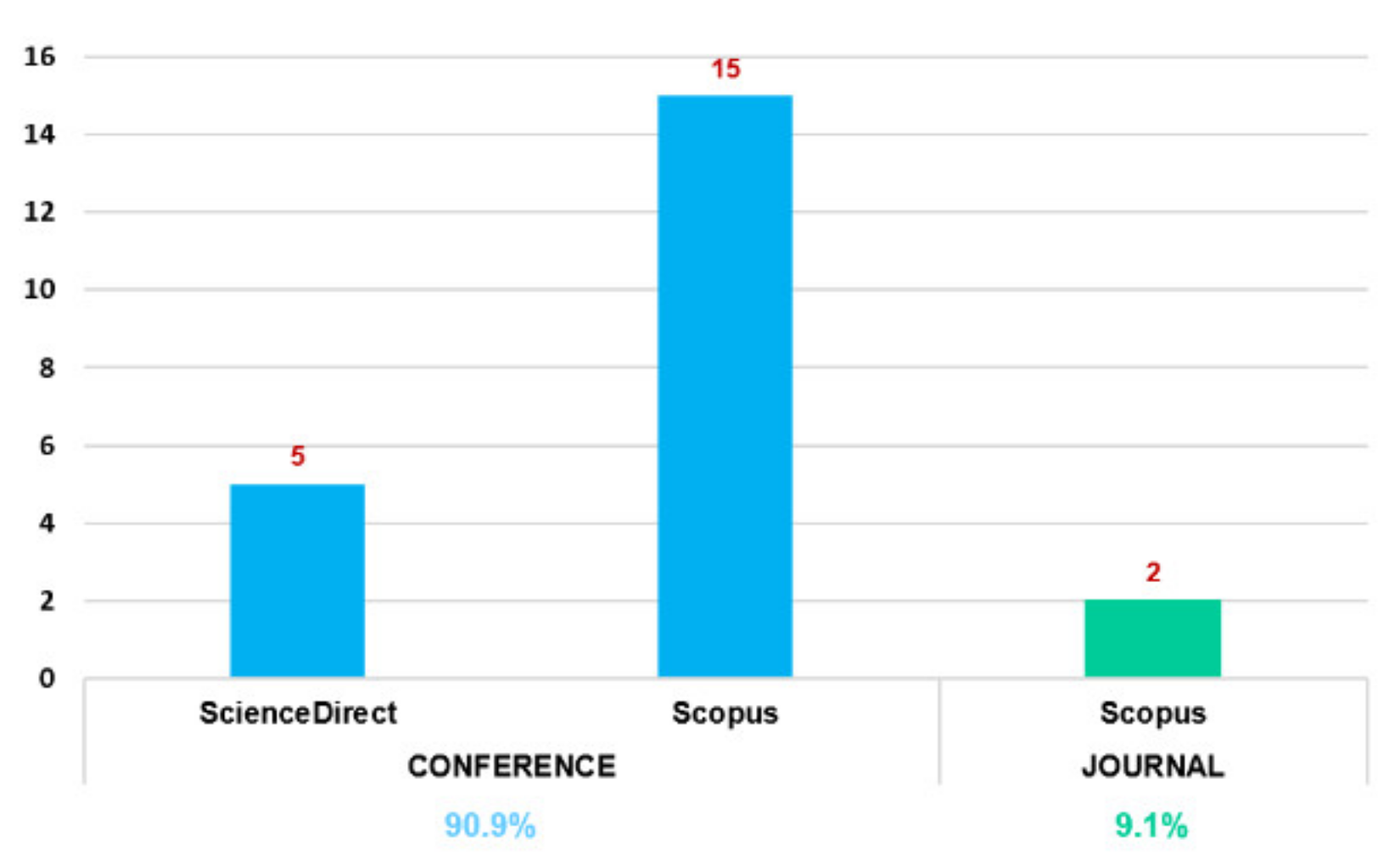
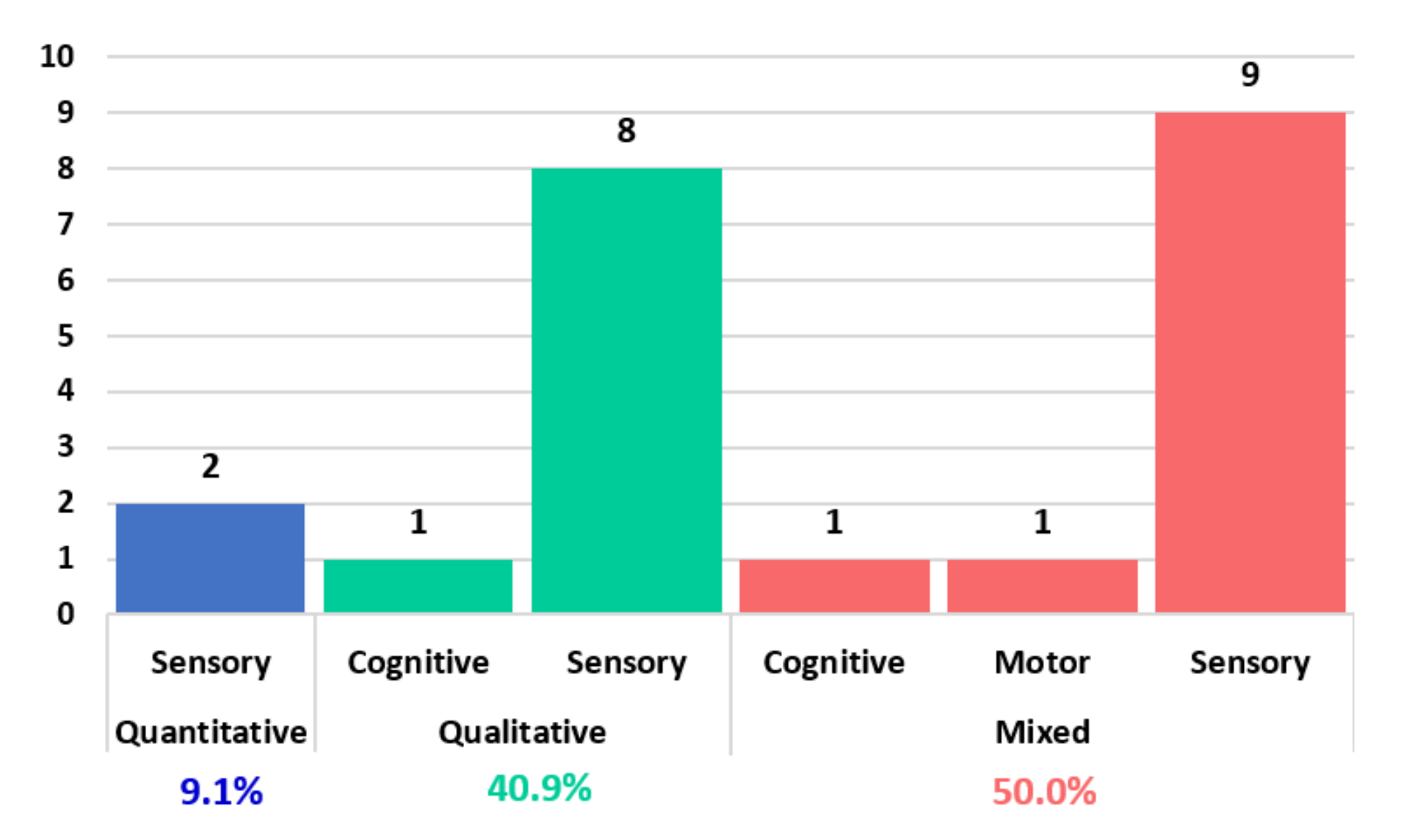
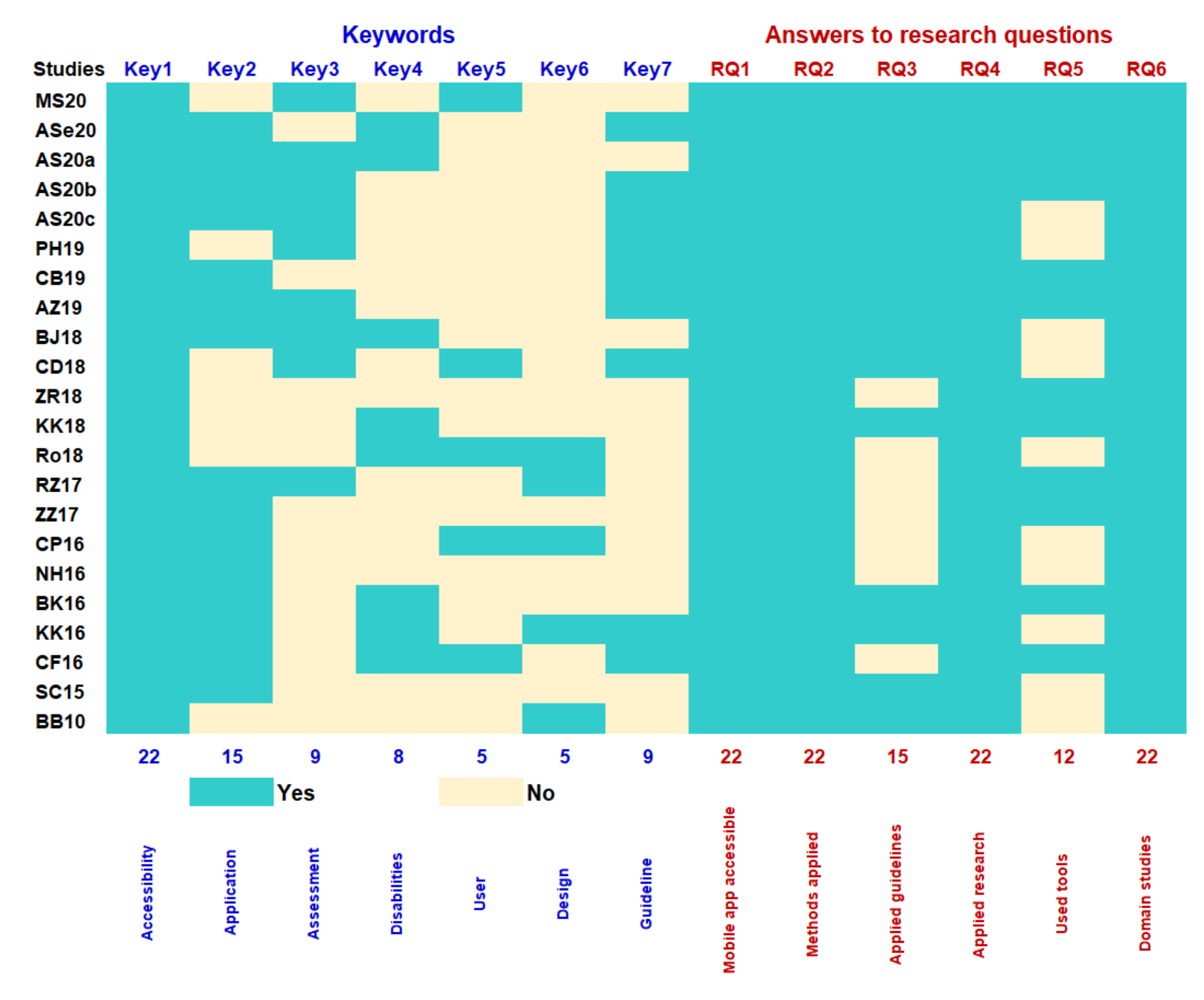
| N° | Quality Assessment Questions | Answer |
|---|---|---|
| QA1 | Is mobile application accessibility detailed in the paper? | (+1) Yes/(+0) No |
| QA2 | Is the mobile application accessibility evaluation method specified in the paper? | (+1) Yes/(+0) No |
| QA3 | Does the paper discuss any findings of mobile application accessibility evaluation? | (+1) Yes/(+0) No |
| QA4 | Are common mobile application accessibility errors described in the results? | (+1) Yes/(+0) No |
| QA5 | Is the journal or the conference where the paper was published indexed in SJR? | (+1) if it is ranked Q1, (+0.75) if it is ranked Q2, (+0.50) if it is ranked Q3, (+0.25) if it is ranked Q4, (+0.0) if it is not ranked. |
| Database | String Search | Studies Number |
|---|---|---|
| ACM Digital Library | [Publication Title: accessi*] AND [Publication Title: mobi*] AND [Publication Title: applica*] AND [Publication Date: (01/01/2000 TO 01/31/2021)] | 35 |
| IEEE Xplore | (“Document Title”: accessibility) AND (“Document Title”: mobile application) | 8 |
| Scopus | Title (accessi*) and (title (mobi*) and title (applica*)) and (limit-to (pubyear, 2021) or limit-to (pubyear, 2020) or limit-to (pubyear, 2019) or limit-to (pubyear, 2018) or limit-to (pubyear, 2017) or limit-to (pubyear, 2016) or limit-to (pubyear, 2015) or limit-to (pubyear, 2014) or limit-to (pubyear, 2013) or limit-to (pubyear, 2012)or limit-to (pubyear, 2011) or limit-to (pubyear, 2010) or limit-to (pubyear, 2009) or limit-to (pubyear, 2008) or limit-to (pubyear, 2007) or limit-to (pubyear, 2006) or limit-to (pubyear, 2005) or limit-to (pubyear, 2004) or limit-to (pubyear, 2003) or limit-to (pubyear, 2002 ) or limit-to (pubyear, 2001) or limit-to (pubyear, 2000)) | 84 |
| ScienceDirect | “accessi*” and “mobi*” and “applica*” | 73 |
| Web of Science | TI = (accessi*) AND TI = (mobi*) AND TI = (applica*) | 11 |
| Total number of studies | 211 |
| ID | Scientific Articles | Quality Assessment | ||||||
|---|---|---|---|---|---|---|---|---|
| QA1 | QA2 | QA3 | QA4 | QA5 | Score | Normalization | ||
| MS20 | Accessibility of mobile applications: Evaluation by users with visual impairment and by automated tools | 1 | 1 | 1 | 1 | 0 | 4 | 0.8 |
| ASe20 | Toward Accessible Mobile Application Development for Users with Low Vision | 1 | 1 | 1 | 1 | 0.5 | 4.5 | 0.9 |
| AS20a | Accessibility Assessment of Mobile Meteorological Applications for Users with Low Vision | 1 | 1 | 1 | 1 | 0.5 | 4.5 | 0.9 |
| AS20b | Heuristic method of evaluating accessibility of mobile in selected applications for air quality monitoring | 1 | 1 | 1 | 1 | 0.5 | 4.5 | 0.9 |
| AS20c | Accessibility assessment in mobile applications for android | 1 | 1 | 1 | 1 | 0.5 | 4.5 | 0.9 |
| PH19 | Development of Automatic Evaluation Tool for Mobile Accessibility for Android Application | 1 | 1 | 1 | 1 | 0 | 4 | 0.8 |
| CB19 | Accessibility in Mobile Applications of Portuguese Public Administration | 1 | 1 | 1 | 1 | 0.75 | 4.75 | 1.0 |
| AZ19 | Accessibility Evaluation of Mobile Applications for Monitoring Air Quality | 1 | 1 | 1 | 1 | 0.5 | 4.5 | 0.9 |
| BJ18 | Study of Accessibility Guidelines of Mobile Applications | 1 | 1 | 1 | 1 | 0 | 4 | 0.8 |
| CD18 | Accessibility and Usability Problems Encountered on Websites and Applications in Mobile Devices by Blind and Normal-Vision Users | 1 | 1 | 1 | 1 | 0 | 4 | 0.8 |
| ZR18 | Robust Annotation of Mobile Application Interfaces in Methods for Accessibility Repair and Enhancement | 1 | 1 | 1 | 1 | 0 | 4 | 0.8 |
| KK18 | UX design guideline for health mobile application to improve accessibility for the visually impaired: Focusing on disease retinitis pigmentosa | 1 | 1 | 1 | 1 | 0 | 4 | 0.8 |
| Ro18 | An assistive mobile application i-AIM app with accessible UI implementation for visually-impaired and aging users | 1 | 1 | 1 | 1 | 0 | 4 | 0.8 |
| RZ17 | Epidemiology as a Framework for Large-Scale Mobile Application Accessibility Assessment | 1 | 1 | 1 | 1 | 0 | 4 | 0.8 |
| ZZ17 | Interaction Proxies for Runtime Repair and Enhancement of Mobile Application Accessibility | 1 | 1 | 1 | 1 | 0 | 4 | 0.8 |
| CP16 | Methods to improve mobile application accessibility through applying a tactile user interface in a smartphone | 1 | 1 | 1 | 1 | 0 | 4 | 0.8 |
| NH16 | Deaf mobile application accessibility requirements | 1 | 1 | 1 | 1 | 0 | 4 | 0.8 |
| BK16 | Accessibility analysis of e-governance oriented mobile applications | 1 | 1 | 1 | 1 | 0 | 4 | 0.8 |
| KK16 | UX Design Guideline for Health Mobile Application to Improve Accessibility for the Visually Impaired | 1 | 1 | 1 | 1 | 0 | 4 | 0.8 |
| CF16 | Accessibility evaluation of Rich Internet Applications interface components for mobile screen readers | 1 | 1 | 1 | 1 | 0 | 4 | 0.8 |
| SC15 | Accessibility Evaluation of E-Government Mobile Applications in Brazil | 1 | 1 | 1 | 1 | 0 | 4 | 0.8 |
| BB10 | A unified methodology for the evaluation of accessibility and usability of mobile applications | 1 | 1 | 1 | 1 | 0.75 | 4.75 | 1.0 |
| No | ID | Title | Reference | Year |
|---|---|---|---|---|
| 1 | MS20 | Accessibility of mobile applications: Evaluation by users with visual impairment and by automated tools | Mateus, D.A. [9] | 2020 |
| 2 | ASe20 | Toward Accessible Mobile Application Development for Users with Low Vision | Acosta-Vargas, P. [2] | 2020 |
| 3 | AS20a | Accessibility Assessment of Mobile Meteorological Applications for Users with Low Vision | Acosta-Vargas, P. [13] | 2020 |
| 4 | AS20b | Heuristic method of evaluating accessibility of mobile in selected applications for air quality monitoring | Acosta-Vargas, P. [12], | 2020 |
| 5 | AS20c | Accessibility assessment in mobile applications for android | Acosta-Vargas, P. [25] | 2020 |
| 6 | PH19 | Development of Automatic Evaluation Tool for Mobile Accessibility for Android Application | Park, E. [15] | 2019 |
| 7 | CB19 | Accessibility in Mobile Applications of Portuguese Public Administration | Carneiro, M. [16] | 2019 |
| 8 | AZ19 | Accessibility Evaluation of Mobile Applications for Monitoring Air Quality | Acosta-Vargas, P. [18] | 2019 |
| 9 | BJ18 | Study of Accessibility Guidelines of Mobile Applications | Ballantyne, M. [17] | 2018 |
| 10 | CD18 | Accessibility and Usability Problems Encountered on Websites and Applications in Mobile Devices by Blind and Normal-Vision Users | Carvalho, M. [26] | 2018 |
| 11 | ZR18 | Robust Annotation of Mobile Application Interfaces in Methods for Accessibility Repair and Enhancement | Zhang, X. [27] | 2018 |
| 12 | KK18 | UX design guideline for health mobile application to improve accessibility for the visually impaired: Focusing on disease retinitis pigmentosa | Kim, W.J. [28] | 2018 |
| 13 | Ro18 | An assistive mobile application i-AIM app with accessible UI implementation for visually-impaired and aging users | Russ, K.C.W. [29] | 2018 |
| 14 | RZ17 | Epidemiology as a Framework for Large-Scale Mobile Application Accessibility Assessment | Spencer, R. [30] | 2017 |
| 15 | ZZ17 | Interaction Proxies for Runtime Repair and Enhancement of Mobile Application Accessibility | Zhang, X. [31] | 2017 |
| 16 | CP16 | Methods to improve mobile application accessibility through applying a tactile user interface in a smartphone | Choi, H. [32] | 2016 |
| 17 | NH16 | Deaf mobile application accessibility requirements | Nathan, S.S. [33] | 2016 |
| 18 | BK16 | Accessibility analysis of e-governance oriented mobile applications | Balaji, V. [34] | 2016 |
| 19 | KK16 | UX Design Guideline for Health Mobile Application to Improve Accessibility for the Visually Impaired | Kim, W.J. [35] | 2016 |
| 20 | CF16 | Accessibility evaluation of Rich Internet Applications interface components for mobile screen readers | Carvalho, L.P. [36] | 2016 |
| 21 | SC15 | Accessibility Evaluation of E-Government Mobile Applications in Brazil | Serra, L.C. [36] | 2015 |
| 22 | BB10 | A unified methodology for the evaluation of accessibility and usability of mobile applications | Billi, M. [37] | 2010 |
| Type of Disability | ID |
|---|---|
| Cognitive (two studies) | NH16, ZR18 |
| Motor coordination (one study) | Ro18 |
| Sensory: visually impaired, hearing (19 studies) | AS20a, AS20b, AS20c, ASe20, AZ19, BB10, BJ18, BK16, CB19, CD18, CF16, CP16, KK16, KK18, MS20, PH19, RZ17, SC15, ZZ17 |
| Method | Cognitive | Motor Coordination | Sensory (Visually Impaired, Hearing) |
|---|---|---|---|
| Automatic (four studies) | AS20c, AZ19, MS20, RZ17. | ||
| Combined: (three studies) | AS20a, ASe20, PH19. | ||
| Heuristic (four studies) | AS20b, BB10, BJ18, SC15. | ||
| Manual (11 studies) | NH16, ZR18. | Ro18. | BK16, CB19, CD18, CF16, CP16, KK16, KK18, ZZ17. |
| Guidelines | Cognitive | Motor Coordination | Sensory (Visually Impaired, Hearing) |
|---|---|---|---|
| WCAG 2.0 (seven studies) | BB10, BJ18, BK16, CD18, KK18, PH19, SC15. | ||
| WCAG 2.1 (seven studies) | AS20a, AS20b, AS20c, ASe20, AZ19, CB19, MS20. | ||
| MWAG (one study) | KK16. | ||
| Other guidelines (seven studies) | NH16, ZR18. | Ro18. | CF16, CP16, RZ17, ZZ17. |
| Research | Cognitive | Motor Coordination | Sensory (Visually Impaired, Hearing) |
|---|---|---|---|
| Mixed (11 studies) | ZR18. | Ro18. | AS20a, AS20b, ASe20, AZ19, BB10, BK16, CB19, CF16, KK16. |
| Qualitative (nine studies) | NH16. | BJ18, CD18, CP16, KK18, MS20, PH19, RZ17, ZZ17. | |
| Quantitative (two studies) | AS20c, SC15. |
| Tool | Cognitive | Motor Coordination | Sensory (Visually Impaired, Hearing) |
|---|---|---|---|
| Accessibility Scanner (seven studies) | AS20a, AS20b, ASe20, AZ19, BK16, KK18, RZ17. | ||
| Not specified (15 studies) | NH16. | Ro18. | AS20c, BB10, BJ18, CD18, CP16, KK16, PH19, SC15, CF16, MS20, ZZ17, CB19. |
| Sector | Studies |
|---|---|
| Administration | CB19 |
| Air quality | AS20b, AZ19 |
| Banking | CD18, AS20c, BJ18 |
| Comunication | PH19, AS20c, BJ18 |
| Education | ASe20, ASe20, BB10, CF16, MS20, NH16, AS20c, BJ18 |
| E-Government | BK16, SC15 |
| Entertainment | AS20c, BJ18 |
| Epidemiology | RZ17 |
| Health | KK16, KK18 |
| Lifestyle | AS20c, BJ18 |
| Meteorology | AS20a |
| Productivity | AS20c, BJ18 |
| Services | CP16, Ro18, ZZ17 |
| Shopping | AS20c, BJ18 |
| Social media | ZR18, AS20c, BJ18 |
Publisher’s Note: MDPI stays neutral with regard to jurisdictional claims in published maps and institutional affiliations. |
© 2021 by the authors. Licensee MDPI, Basel, Switzerland. This article is an open access article distributed under the terms and conditions of the Creative Commons Attribution (CC BY) license (https://creativecommons.org/licenses/by/4.0/).
Share and Cite
Acosta-Vargas, P.; Salvador-Acosta, B.; Salvador-Ullauri, L.; Villegas-Ch., W.; Gonzalez, M. Accessibility in Native Mobile Applications for Users with Disabilities: A Scoping Review. Appl. Sci. 2021, 11, 5707. https://doi.org/10.3390/app11125707
Acosta-Vargas P, Salvador-Acosta B, Salvador-Ullauri L, Villegas-Ch. W, Gonzalez M. Accessibility in Native Mobile Applications for Users with Disabilities: A Scoping Review. Applied Sciences. 2021; 11(12):5707. https://doi.org/10.3390/app11125707
Chicago/Turabian StyleAcosta-Vargas, Patricia, Belén Salvador-Acosta, Luis Salvador-Ullauri, William Villegas-Ch., and Mario Gonzalez. 2021. "Accessibility in Native Mobile Applications for Users with Disabilities: A Scoping Review" Applied Sciences 11, no. 12: 5707. https://doi.org/10.3390/app11125707
APA StyleAcosta-Vargas, P., Salvador-Acosta, B., Salvador-Ullauri, L., Villegas-Ch., W., & Gonzalez, M. (2021). Accessibility in Native Mobile Applications for Users with Disabilities: A Scoping Review. Applied Sciences, 11(12), 5707. https://doi.org/10.3390/app11125707










